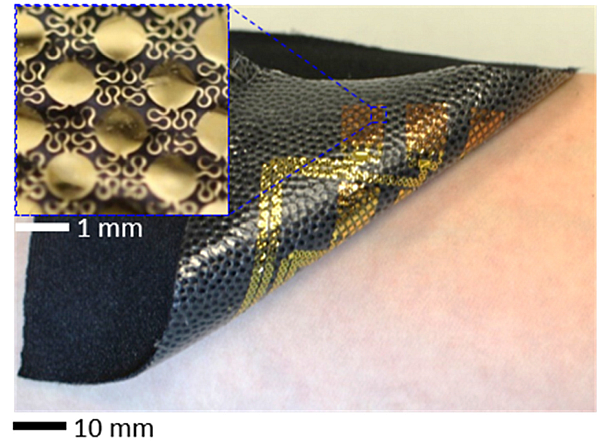Patients recovering from spinal cord injuries or who have mobility disorders related to spinal nerve compression are frequently treated by the conditioning of the Hoffmann’s reflex via non-surgical electrostimulation therapy. To track the progress of the treatment, electromyography (EMG) is used to record the amplitude of the patient’s muscle twitch response.
Accurate EMG recording requires precise positioning of electrodes; thus, the existing systems have to use too many electrodes to cover the target skin. In addition, the current systems are relying on rigid and bulky metal electrodes, strong adhesives, and skin-irritable conductive gels. These system constraints increase error instances across sessions in experimentation, as well as requiring lengthy set-up times.
To address these issues, The Bio-Interfaced Translational Nanoengineering Group, under the direction of Assistant Professor W. Hong Yeo, George W. Woodruff School of Mechanical Engineering and Wallace Coulter Department of Biomedical Engineering at Georgia Tech, have created a nanomembrane electrode EMG array for use on large epidermal areas that has the potential to reduce greatly these problems in critical therapeutics for rehabilitation.
This new large-area epidermal electronic system (L-EES) provides greater patient comfort through enhanced skin-compatibility via a stretchable and breathable composite. For researchers and therapists, the system could provide a reliable recording of electromyographic muscle signal activities (M-waves and H-reflex) from patients that are comparable to those recorded using conventional EMG systems.
Read the Research Here: Breathable, large-area epidermal electronic systems for recording electromyographic activity during operant conditioning of H-reflex
Media Relations Contact: Christa Ernst (christa.ernst@research.gatech.edu)
Media Contact
Keywords
Latest BME News
Jo honored for his impact on science and mentorship
The department rises to the top in biomedical engineering programs for undergraduate education.
Commercialization program in Coulter BME announces project teams who will receive support to get their research to market.
Courses in the Wallace H. Coulter Department of Biomedical Engineering are being reformatted to incorporate AI and machine learning so students are prepared for a data-driven biotech sector.
Influenced by her mother's journey in engineering, Sriya Surapaneni hopes to inspire other young women in the field.
Coulter BME Professor Earns Tenure, Eyes Future of Innovation in Health and Medicine
The grant will fund the development of cutting-edge technology that could detect colorectal cancer through a simple breath test
The surgical support device landed Coulter BME its 4th consecutive win for the College of Engineering competition.








